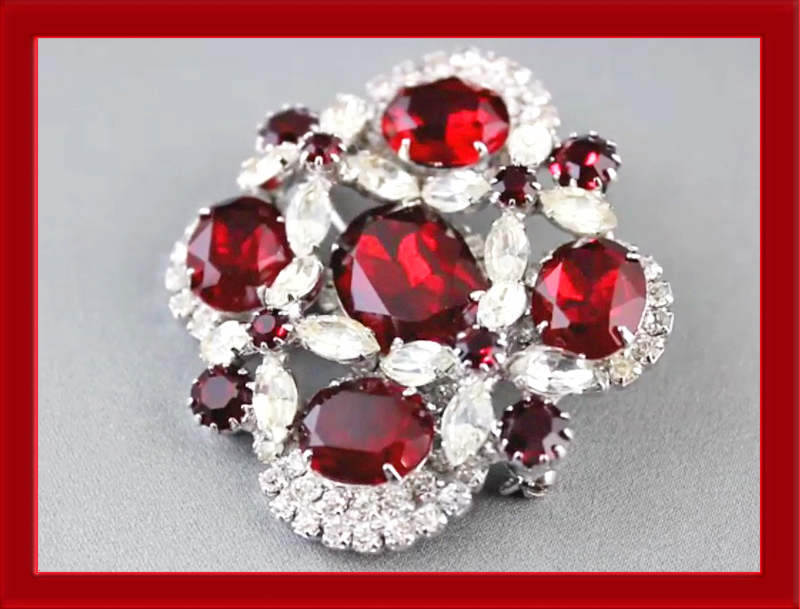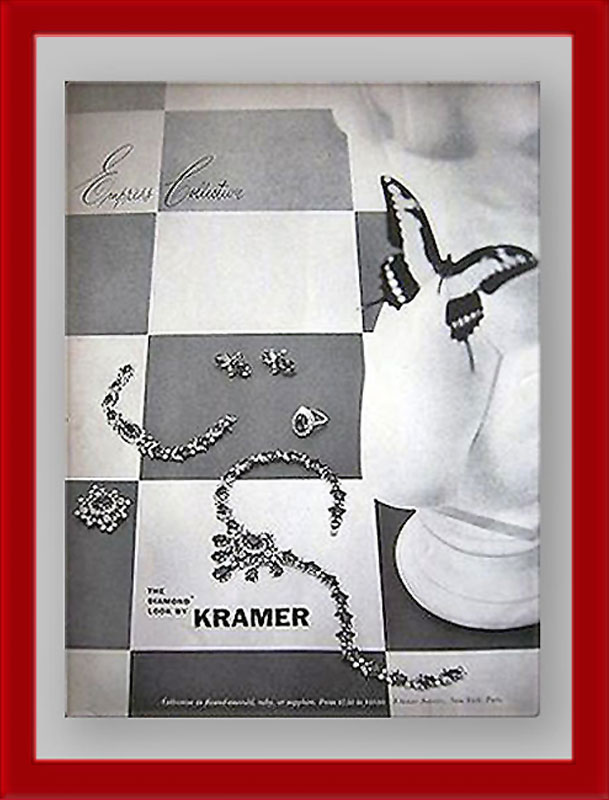Return To Previous Page
Kramer | Ruby Empress Brooch
View
video
Kramer | Ruby Empress Brooch
. . . . Regal!
Kramer
An heirloom piece for sure. This lovely brooch was part of the Empress Collection. The ad above displays a lovely parure from the Empress Collection. "The Diamond Look", a slogan used for Kramer ads, was not an exaggeration. For those who could not afford real diamonds this must have been like getting the 'real thing.' The royalty inspired Empress Collection by Kramer included formal designs of royal gemstone colors—emerald, ruby, sapphire—delicately surrounded by rhinestones that glistened like diamonds. The ruby rhinestones are spectacular—a lavish piece of vintage history—giving your chosen attire an over all appearance of opulent extravagance. Please be sure to 'view video' above to see the beautiful sparkle and condition of this lovely brooch. ID-464
Measurements:
Brooch — Approximately 2 ¼ inches.
Kramer Jewelry History —
Louis Kramer opened his firm in New York City in 1943 and made a range of variously priced costume jewelry for the following 30 years. Like Weiss he was a believer in stone-rich designs, a look that found particular favor in the 1950s climate of dressed-up glamour. Kramer used a wider variety of paste than either Weiss or post-war Eisenberg designing pieces decorated with textured or “crackled” glass, crystal beds, colored pearls, and even plastics. Rhinestones overlaid with black fishnet are another distinctive Kramer innovation, and this interesting fusion of clothing and jewelry elements has made these unusual net pieces highly desirable for today’s collectors. Another collectable line is the series of jewels that Kramer manufactured in the United States for Christian Dior. While not as valuable as Dior’s French, English or German produced pieces, “Dior By Kramer” is eagerly collected and prices continue to rise.
Most Kramer pieces are abstract in design, but a limited number of animals, insects, flowers and crowns occasionally appear and prices for these are still modest. Collectors prefer Kramer’s wide bracelets, especially those with mixed color palettes of subtly ranged shades. Large rhinestone bibs, bows and waterfall necklaces are also favored in richer colors, while clear paste examples fetch slightly less. A full Kramer parure in mint condition is always worth buying and will make a better investment than a comparable unsigned example.
The mark “Kramer N.Y.” and a grey pewter-tone setting both suggest that a piece dates from the 1940s or early ‘50s—the era that collectors consider Kramer’s best. Pieces marked simply “Kramer” are believed to be later. However, costume jewelry signatures are not always uniform and chronological and dating often comes down to an educated guess based on stylistic characteristics.
In the early days of collectable costume jewelry, both Kramer and Weiss were relegated to the second or third divisions, but because collectors have recently com to value paste-rich jewelry styles, prices for both makers have risen sharply in the last few years.
Book: by Steven Miners. [2006]. Miller’s Costume Jewelry: How to Compare & Value, Octopus Publishing Group, Heron Quays, London — Kramer: [Page 114].
Having trouble with the small sizes of
yesteryear? Well, most of us do!
The ladies were smaller than the women of today.
NO Problem, be sure to check out our necklace extenders.
The ladies were smaller than the women of today.
NO Problem, be sure to check out our necklace extenders.

